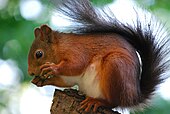
Squirrels are members of the family Sciuridae, a family that includes small or medium-sized rodents. The squirrel family includes tree squirrels, ground squirrels, and flying squirrels. Squirrels are indigenous to the Americas, Eurasia, and Africa, and were introduced by humans to Australia. The earliest known fossilized squirrels date from the Eocene epoch, and among other living rodent families, the squirrels are most closely related to the mountain beaver and to the dormice.

Flying squirrels are a tribe of 50 species of squirrels in the family Sciuridae. Despite their name, they are not in fact capable of full flight in the same way as birds or bats, but they are able to glide from one tree to another with the aid of a patagium, a furred skin membrane that stretches from wrist to ankle. Their long tails also provide stability as they glide. Anatomically they are very similar to other squirrels with a number of adaptations to suit their lifestyle; their limb bones are longer and their hand bones, foot bones, and distal vertebrae are shorter. Flying squirrels are able to steer and exert control over their glide path with their limbs and tail.

Sciurinae is a subfamily of squirrels, uniting the flying squirrels with certain related tree squirrels. Older sources place the flying squirrels in a separate subfamily (Pteromyinae) and unite all remaining sciurids into the subfamily Sciurinae, but this has been strongly refuted by genetic studies.

Castoridae is a family of rodents that contains the two living species of beavers and their fossil relatives. A formerly diverse group, only a single genus is extant today, Castor. Two other genera of "giant beavers", Castoroides and Trogontherium, became extinct in the Late Pleistocene.
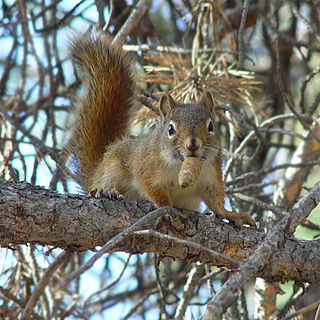
Pine squirrels are squirrels of the genus Tamiasciurus, in the Sciurini tribe, of the large family Sciuridae.

Ground squirrels are rodents of the squirrel family (Sciuridae) that generally live on the ground or in burrows, rather than in trees like the tree squirrels. The term is most often used for the medium-sized ground squirrels, as the larger ones are more commonly known as marmots or prairie dogs, while the smaller and less bushy-tailed ground squirrels tend to be known as chipmunks.

Eutamias is a genus of chipmunks within the tribe Marmotini of the squirrel family. It includes a single living species, the Siberian chipmunk. The genus is often treated as a subgenus of Tamias, which is now restricted to the eastern chipmunk of North America. Neotamias, which now includes the western North American chipmunks, has also been included in Eutamias.
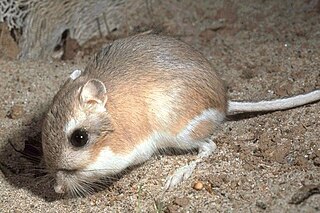
Geomyoidea is a superfamily of rodent that contains the pocket gophers (Geomyidae), the kangaroo rats and mice (Heteromyidae), and their fossil relatives.

The genus Sciurus contains most of the common, bushy-tailed squirrels in North America, Europe, temperate Asia, Central America and South America.

The Amazon dwarf squirrel is a chipmunk-sized tree squirrel native to South America.

The Neotropical pygmy squirrel is a South American species of tree squirrel, being the only living species in the genus Sciurillus and the subfamily Sciurillinae. Genetic analysis has shown it to be the sister group to all other squirrels.

Microsciurus or dwarf squirrels is a genus of squirrels from the tropical regions of Central and South America.

Eomyidae is a family of extinct rodents from North America and Eurasia related to modern day pocket gophers and kangaroo rats. They are known from the Middle Eocene to the Late Miocene in North America and from the Late Eocene to the Pleistocene in Eurasia. Eomyids were generally small, but occasionally large, and tended to be squirrel-like in form and habits. The family includes the earliest known gliding rodent, Eomys quercyi.
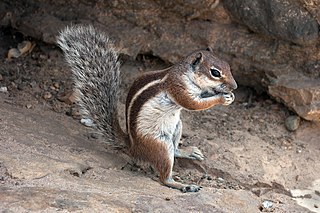
The Barbary ground squirrel is a species of rodent in the family Sciuridae. It is monotypic within the genus Atlantoxerus. It is endemic to the Atlas mountains in Morocco and some parts in Algeria, and has been introduced into the Canary Islands. Its natural habitats are subtropical or tropical dry shrubland, temperate grassland and rocky areas where it lives colonially in burrows. It was first described by Carl Linnaeus in his landmark 1758 10th edition of Systema Naturae.
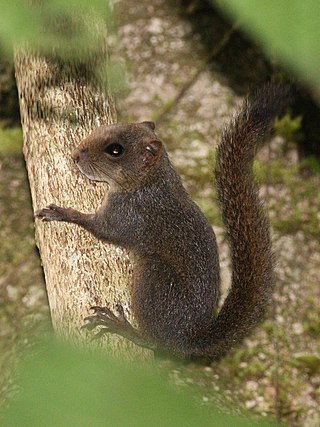
The Central American dwarf squirrel, also known as Alfaro's pygmy squirrel, is a small tree squirrel in the genus Microsciurus and tribe Sciurini found in Colombia, Costa Rica, Nicaragua, and Panama. No species of squirrel within this genus are listed as endangered, however they are rarely seen because they are extremely elusive. This suggests that their population numbers may be larger than documented.

The western dwarf squirrel is a small tree squirrel in the genus Microsciurus and tribe Sciurini found in Colombia, Ecuador, and Panama.

The Santander dwarf squirrel is a small tree squirrel endemic to Colombia.
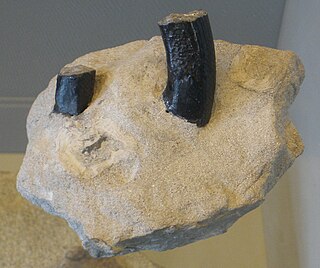
Anchitheriomys is an extinct member of the beaver family, Castoridae. It inhabited North America and Eurasia during the middle Miocene. The name of the genus comes from Anchitherium, an extinct genus of horses, and the Greek word for mouse, μῦς (mys), thus meaning "Anchitherium's mouse", because the fossils of both genera usually co-occur.
Lagrivea is a fossil genus of squirrel from the Middle Miocene of France. The single species, L. vireti, is known from three mandibles and two isolated teeth. All come from the fissure filling of La Grive L5, part of the La Grive-Saint-Alban complex in Saint-Alban-de-Roche, southeastern France. Lagrivea was a large tree squirrel with flat lower incisors and a large, triangular fourth lower premolar (p4). Each of the four cheekteeth bears a deep basin in the middle of the crown. The m3 is about rectangular in shape, but rounded at the back. Although m1 and m2 have two roots, m3 has three.

Sciurus ingrami, usually called Ingram's squirrel in English, is a squirrel found in South America. It is known as serelepe in southeastern Brazil. It is found in the Atlantic Forest Biome of Brazil and Misiones Province, Argentina.



















